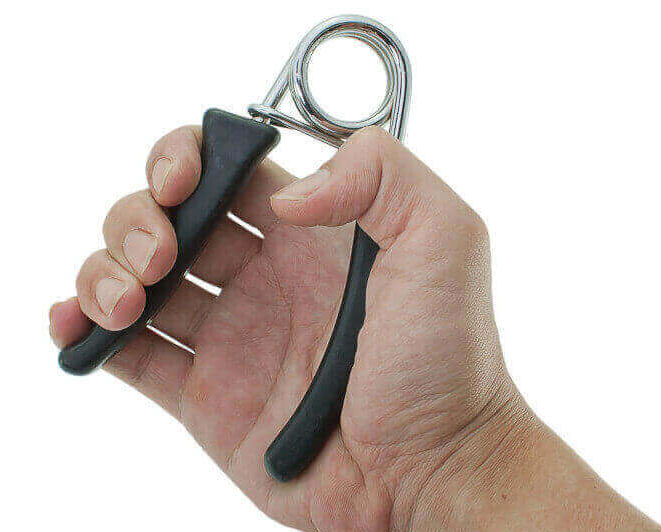Guide to Carpal Tunnel & Hand Strength
From Dr. Z - Carpal tunnel syndrome specialist
With Carpal Tunnel, Hand Strength Loss is Inevitable
For people with carpal tunnel, hand strength loss becomes a part of life. It's both inconvenient and worrisome. Dropping things due to weakness is bad enough. But the real worry should be if the condition will worsen
- because it usually does.
In general, losing strength and dexterity in your fingers and hand is a sign that
carpal tunnel syndrome is advancing. So if you have carpal tunnel hand (& strength diminishes) you must take action immediately.
Don’t ignore the signs!
Noticing hand weakness while trying to open a door or pick up a coffee cup means you need help now, not tomorrow.
Actually, one of the things
about carpal tunnel is that most patients wait until they drop things to do anything about it. By then, the condition has
advanced. The best advice is to solve the problem before it worsens.
- FIND OUT: do you have carpal tunnel? No strings attached self-test.
Carpal tunnel hand strength and dexterity
The typical first signs of carpal tunnel syndrome are numbness and tingling in your fingers and hand. Afterwards, pain may follow (sometimes taking a long time). As the condition progresses, hand strength and dexterity are diminished.
You will notice that relatively simple tasks like using a comb or a toothbrush are difficult or even impossible. Tightly gripping handles like a golf club or your car’s steering wheel while driving often makes your hand hurt or go numb.
Fine motor skills generally diminish as well. For example, it’s awkward to pick up small objects like keys, coins or a pen. Tying a shoelace or buttoning a shirt is clumsy. In particular, writing, playing an instrument, and using a phone are noticeably more difficult. Many people see symptoms start while typing on a keyboard.
The problem is nerve damage
Symptoms of carpal tunnel & hand strength loss stem from one thing; nerve damage. Carpal tunnel syndrome happens because tendons crush the median nerve inside the tightly packed carpal tunnel space (inside the wrist joint).
The crushing occurs because tendons adjacent to the nerve inflame and swell. Consequently, they squeeze the nerve and slowly crush it.
The median nerve is the primary route for sensory signals from the hand to the brain. In fact, it carries sensory signals from the thumb, index finger, middle finger, and part of the ring finger. It also is a motor nerve route for moving finger muscles. Thus, any interference with this nerve interferes with the hand’s sensory and motor abilities.
The nerve is damaged from being crushed
The pain, numbness or tingling you feel with carpal tunnel is due to a crushed median nerve. It’s similar to resting your elbow on a table for an extended period of time. Consequently, your hand “falls asleep” or goes numb.
Similarly, sitting on a hard surface can make your leg have “pins and needles” or go numb. In both instances the sensations are due to crushing the nerve in that limb, just like with carpal tunnel syndrome.
In all instances, the symptoms don't come from the limb. They occur due to injury further back toward the body.
Nerves don’t like compression anywhere along their length. This is why, with carpal tunnel syndrome, you have the feelings of numbness or tingling in your fingers. However, the problem is in the wrist, not the fingers. So that’s the location of your carpal tunnel; hand strength loss and dexterity problems are just the result.
Sometimes the median nerve is compressed for a long period of time and with no intervention. As a result, it's severely and permanently damaged. The degree of damage varies from individual to individual.
But sometimes it can bounce back! The nerve’s ability to bounce back to normal depends on many factors. Most are a mystery to science.
Restoring carpal tunnel hand strength
For decades doctors have documented treatment statistics on carpal tunnel syndrome. As a result, data clearly shows the earlier you treat symptoms, the better your chances of restoring function lost due to carpal tunnel. Hand strength loss is just one of those functions.
Many doctors claim that surgery is the best intervention. However, the American Academy of Orthopedic Surgeons (who regulate hand surgery) advises you should try using all nonsurgical techniques first. That’s because they work. In contrast, hand surgery only has a 50% success rate as determined by patient satisfaction at 2 years post-surgery.
Generally, the most effective nonsurgical technique is the B.R.E.M. combination. That stands for the 4 key techniques doctors recommend most for carpal tunnel patients: Brace, Rest, Exercise & Massage.
Brace
Rest
Rest involves avoiding or restricting the activities that started the problem to begin with. In fact, just cutting down such activities by half can eliminate symptoms in most cases of mild or moderate carpal tunnel syndrome. But severe carpal tunnel syndrome requires more therapy.
Exercise
Hand and finger exercises and stretching involve taking short “mini-breaks”. For example, take just 30 seconds during every 30 minutes of work to stretch your fingers and hands. Regular stretching exercises are one of the best defenses against carpal tunnel syndrome.
Massage
Massage your wrist area using the myofascial release technique. This breaks up adhesions and drains excess fluid from the wrist joint. As a result, it relieves pressure buildup and symptoms resolve. A daily therapy regimen lasting 4 weeks is usually required.
Summary
Carpal tunnel & hand strength loss are almost synonymous. So is the associated pain, numbness and tingling. These are major issues with this condition, and also hardest to treat when the condition advances. Therefore, it’s important to intervene before irreversible hand muscle degeneration occurs.





